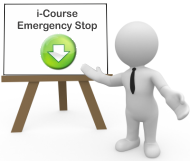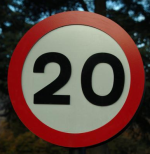Emergency stop project
 For this project you will complete a minimum of four 'emergency stops' ideally in both wet and dry conditions.
For this project you will complete a minimum of four 'emergency stops' ideally in both wet and dry conditions.
It is essential that you follow the instructions on the right and in the workskeets with regard to safety precautions.
Ideally the stops should be done off public roads; e.g.,, on a disused airfield or a private road. If this is not possible, choose a very quiet road and do the initial exercise in dry weather.
If you use public roads choose a clear stretch of road away from junctions and parked cars. Remember your first responsibility is safety and second, consideration for others. Explaining to police officer the you are training to be advanced driver is unlikely to gain much sympathy!
You will need an adult passenger to help you with this project - preferably an experienced driver. Without a passenger you will not be able to simulate the surprise of a real emergency and you will get an unrealistic stopping distance. Your passenger is also a second set of eyes to ensure safety.
You must use your own commonsense as an experienced driver and exercise care in deciding when, where and at what speeds you choose to do this exercise.
Stopping
You friend will give you the instruction to 'STOP!' (as explained in the project instructions on the right). When the instruction is given you must stop as quickly as possible while remaining in full control of the vehicle.
In order to keep control ensure that you:
- Keep both hands on the steering wheel until after the car has stopped
- Press the foot-brake before the clutch until you are fully confident with your ability.
Next: Read the four step project instructions on the right and then complete the exercises.
If you have not already done so, download the project worksheet before you go out to practise.
 To ensure maximum safety during the emergency stop exercise, the road behind must be clear.
To ensure maximum safety during the emergency stop exercise, the road behind must be clear.
Your passenger's job (and your's when you are teaching) is to TURN ROUND and check that the road behind is safe before the exercise is carried out. Looking in the mirrors is not enough.

Drive at about 20mph for the first stop.
Remember, your passenger must look behind to ensure that it is safe. When the road is totally clear ahead and behind your passenger should give the instruction 'STOP!'
For best results this instruction should, as far as possible, take you by surprise.
 Your assistant needs to remember, exactly, where the command to stop was given. To help with this he/she should use a marker, such as a post or tree beside the road. After you have stopped park the car.
Your assistant needs to remember, exactly, where the command to stop was given. To help with this he/she should use a marker, such as a post or tree beside the road. After you have stopped park the car.
Next, pace out the distance from where you stopped (from the front of your car) back to where the instruction to stop was given. Check the length of your paces so that you can measure the distance in metres or feet and fill in the results on your project sheet.
 Repeat the exercise at 30, 40 and 50 mph.
Repeat the exercise at 30, 40 and 50 mph.
Take special care as the speed increases remembering that hard braking can induce skids - Never practise on poor or greasy road surfaces, in conditions of snow or ice or on roads with pot holes.
You might choose to do an optional exercise on a wet road - if you do this take extra care and limit your speed to a maximum of 30 mph.